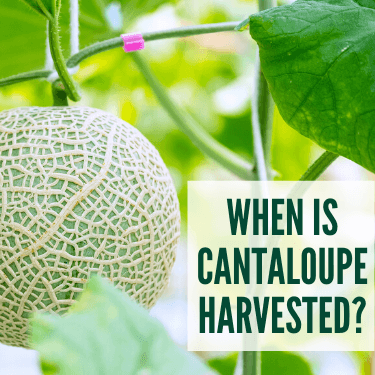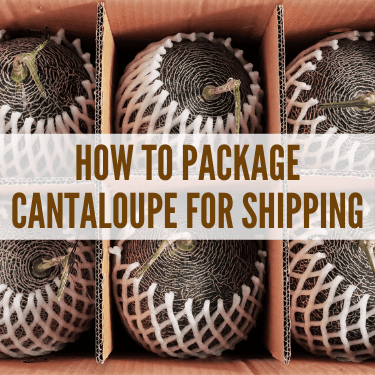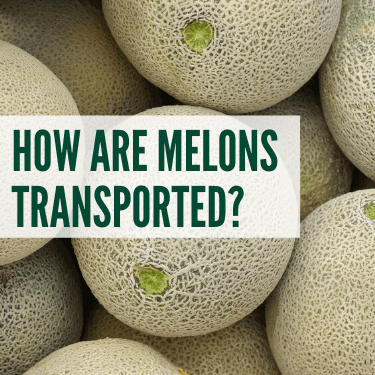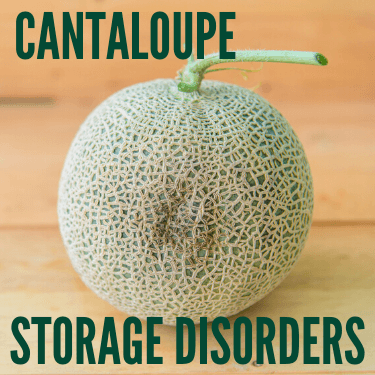Cantaloupes are a hugely popular fruit to have for breakfast, dessert, snacks, and summertime picnics. In fact, the United States is the largest consumer of melon in the world, and the average American consumes roughly 27 pounds of melon a year! The recent development of sweeter and seedless varieties continues to improve the popularity of this tasty melon. Since melons only grow in warmer climates, truckload shipping has to be utilized to transport those delicious fruits north for all American consumers to enjoy. If you are planning on shipping cantaloupe by the truckload for the harvest season, this guide can help give you an idea of how to get your melons delivered safely and on-time.
Shipping cantaloupe involves carefully controlling the temperature and humidity during transportation, to prevent early spoilage and a variety of storage disorders. After field packaging, cantaloupes can be loaded up on a temperature-controlled freight truck to be shipped expedited across the United States.
The United States is a top producer of cantaloupes in the world, ranking 5th globally for the production of the sweet melon. The value of the commodity in the U.S. exceeded $261 million in 2015, and it continues to be a consumer favorite.
Most of the cantaloupes consumed in the U.S. are domestically grown, in the warm southern states of California and Arizona, with California producing 75%. These states produce the vast majority of U.S. Cantaloupe since their warm winters and sandy soil provide the optimal conditions for growth.
Another reason why those states are perfectly suited for cantaloupe farming is because of their limited rainfall. Too much moisture can cause root rot in the plants and may cause the melons to split and deteriorate before they even have a chance to ripen. Since much of California and Arizona is made up of dry desert land, the melons are able to reach maturity without experiencing any serious moisture-related problems.

This might come as a surprise, but cantaloupe was once considered a seasonal treat. Melons would be harvested in the fall, and then consumers would have to wait a year to be able to enjoy them again. Thankfully, that is no longer the case. Advancements in farming technology and the development of new, hardier varieties of cantaloupe has lengthened the growing season to allow for melons to be available year-round.
California and Arizona are known for having warm winters and favorable conditions, allowing cantaloupes to grow year-round. Staggering when seeds are planted can allow for harvests throughout the spring, summer, and fall, with peak season stretching from April all the way through December.
In addition to that, when cantaloupes cannot be produced domestically, the nation’s strong import infrastructure allows for cantaloupe to be imported in from Guatemala and Costa Rica during the off-season.
As with any type of produce, cantaloupe is subject to specific grading standards as outlined by the United States Department of Agriculture (USDA). These grading standards are what determines how much the melons can sell for, what they can be used for, and how and where they should be marketed. If the melons do not meet any of these grading standards, then they must be discarded since they wouldn’t be fit to consume.
In order to be graded, all melons must be mature but not overripe, and not soft, decaying, or wilting.
The grades for cantaloupe are as follows:
All samples for grading should be large enough to be considered representative of the batch, which usually includes about 2% of the melons in the batch. If the cantaloupes are grown over a wide acreage, then melons should be selected from multiple different locations to get a good idea of how the overall batch should be graded. If different areas of the farm produce melons of a different quality, then melons from similar parts of the field should be grouped together and examined separately.
To obtain an official grade, the melons would need to be inspected by a USDA licensed inspector, and they would be responsible for reporting not only the grade of the melons, but also the size, shape, color, number of boxes, and the way the melons are packed in those boxes. All of this is to record the quality of the melons before shipping, and the likelihood of them experiencing any damage en route.

Cantaloupes are harvested when they can easily be separated from the vine by gently twisting or applying pressure to the stem. By that stage, they are usually almost completely ripe and sweet, and have a more golden color instead of the green of the unripe fruit. Once the fruit is off the vine, it must be handled carefully, since pathogens and pests can easily enter into the stem scar.
Each melon is pulled off the vine by hand, but each farm utilizes different techniques for packaging them. The most popular options both involve what is known as “field packing.”
The first method involves harvesting, inspecting, grading, and packaging the cantaloupes while they are still in the field. These cantaloupes are placed into their final boxes or shipping containers and palletized, before being loaded onto a truck. That truck would then transport the melons to a local market or grocery store, or to a temperature-controlled facility to prepare the fruits for long-distance shipping.
The second option also involves harvesting, inspecting, and grading the melons while still in the field, but they are then loaded into large bins or trailers, or they are placed on a conveyor belt. The melons are then transported a short distance to a packing house where the cantaloupes are hydro-cooled, cleaned, and carefully packaged in cartons or crates for shipping.
Regardless of the method of packaging, farmers should strive to keep cantaloupes tightly packed together to minimize shifting around during shipping. If the melons are able to move around even slightly in their boxes then they will likely knock into each other, causing severe bruising. However, they should not be so tightly wedged together that they get smashed. If necessary, padding can be used to fill in the gaps between cantaloupes to ensure they do not have excess space in the box.
In both packaging cases, the melons are stored in a temperature-controlled facility to preserve freshness and quality until they are able to be shipped out around the U.S.
After the cantaloupes are harvested and placed in storage, they should be kept within a temperature range of 36-41 degrees Fahrenheit. They must be allowed to cool after harvest, or they would continue to ripen and could begin to decay before they have had a chance to reach the final consumer. Keeping them too warm for too long could also encourage pests and mold to thrive, thus destroying the melon’s quality.
However, cantaloupes are tropical fruits that grow in particularly warm climates, and as a result, they do not handle overly cold temperatures well. Cantaloupes, like many other melons, are extremely frost-sensitive. They may stay nice if kept in temperatures colder than 36 degrees Fahrenheit, but the moment they are removed from those temperatures, they will begin rapidly deteriorating.
To keep cantaloupes fresh throughout the shipping process, the temperature should be carefully monitored to make sure it stays within an acceptable range. Temperatures that are too hot or too cold can negatively impact the fruit’s shelf life in different ways, and fluctuating temperatures can result in rapid deterioration and decay.

Because of the developed cantaloupe farming industry in the United States, cantaloupes are generally grown domestically and shipped around the country on freight trucks. However, there are a few options regarding freight trucks that shippers can choose from to suit their individual needs.
One of the options available to shippers is refrigerated trucks and vans. Many shipping and logistics companies offer freight trucks with refrigerated trailers that can precisely control the temperature inside. Refrigerated shipping is obviously beneficial for a commodity like cantaloupes, which must be kept within a particular temperature range for the duration of their journey across the states.
Another option is a shipping technique known as “expedited shipping.” If a shipper elects to have their cantaloupes shipped expedited, that means that their shipment will be given priority over other shipments being moved by the transport company or 3PL. The shipment will be loaded onto a truck and shipped out before other shipments, even if those other orders were placed first.
Once the expedited shipment is on the road, drivers are often able to deliver the goods anywhere between a few hours to a few days later, depending on the distance. This is made possible through a combination of full truckload shipping to eliminate unnecessary stops, overnight driving, and driver teams to keep the freight moving close to 24 hours a day.
Shipping cantaloupes expedited can be a good idea, especially if they need to be transported a longer distance. Because of the commodity’s perishable nature, shipping cantaloupes expedited could increase overall profits for farmers and retailers, since the melons would get more time to sit on grocery shelves to be marketed to—and bought by—consumers.
Although refrigerated trucks and expedited shipping will fetch you a higher price for moving your goods, it would be much more expensive to lose an entire shipment of cantaloupe due to improper temperatures or shipping delays.
If cantaloupes are kept in the proper conditions, then they can be expected to last 14-18 days after harvest on average. However, there are many factors that out extend or shorten that shelf life. For example, cantaloupes require a relatively high humidity (95%) in order to keep from drying out. If they are kept in conditions that are too dry, then they could shrivel and lose their sweet flavor, while too much moisture could cause the rinds to become soggy and begin decaying.
As stated above, temperature plays a huge role in the shelf life of uncut cantaloupes. If a fresh, uncut cantaloupe is refrigerated for even a single day below 36 degrees Fahrenheit, then it would immediately begin to break down as it reaches room temperature again. It is better to keep melons in a warmer environment than it would be to keep them too cold.
By carefully maintaining the proper, consistent temperature and humidity, you may be able to keep melons fresh for longer than 18 days, greatly improving the likelihood of a customer purchasing the cantaloupes before they spoil.

There are many things that can go wrong when storing and shipping cantaloupes. Even if the temperatures are carefully controlled and all the conditions are favorable for keeping the melons fresh, problems can still arise. Pests, mold, fungus, and disease can wreak havoc on cantaloupes in storage, even if it seems like you’ve done everything right.
Here are some examples of common storage disorders that affect cantaloupes:
That’s a huge list of potential storage disorders that can damage or completely destroy a batch of cantaloupes—and that’s not even everything. Various insect infestations and other pest problems can also create difficulty for farmers and shippers. In severe cases, an entire harvest can be completely destroyed because of a failure to control the various conditions that can affect cantaloupes in storage and transportation.
The best way to prevent and mitigate issues like these is to have a Hazard Analysis and Critical Control Point (HACCP) plan in place. Although it isn’t a requirement for shippers of fresh produce, it provides an excellent framework for preventing storage disorders like the ones listed above from developing or getting out of control. A good HACCP plan involves enforcing good hygiene standards for workers, properly training those involved with handling the produce, providing the proper equipment for handling the produce safely, and ensuring that all facilities are properly sanitized to prevent the spread of those conditions.
By engaging in risk management and hazard prevention measures, farmers can increase the number of fresh, healthy, high-grade melons that make it to market each season.
If you’re planning on shipping cantaloupe to consumers across the U.S., you’re going to need a trusted partner to get your melons distributed quickly and correctly. When even slight changes to the cantaloupes’ environment can negatively impact your profit margin, you need a shipping company that can control every aspect of the produce’s journey across the states. That’s what R+L Global Logistics is for.
R+L Global Logistics is one of the fastest-growing 3PLs in the nation. Our trusted network of carriers is one of the most reliable in the industry, and we can offer results like no other. With our 99.5% on-time delivery record and our commitment to personalizing our customers’ experiences, we can guarantee the safe and timely delivery of your shipment, no matter what. If you’re shipping from Arizona to Texas, or anywhere else in the U.S., you know you can rely on the R+L promise.
No matter what your shipment requires, whether that’s refrigerated, expedited, or just regular truckload shipping, we can provide the services you need to succeed. Shipping cantaloupe doesn’t have to be difficult. If you want a stress-free experience and the peace of mind associated with working with experts in the shipping industry, reach out to us at (866) 353-7178 to get a free freight rate quote today, and we’ll make it worth your time.
R+L Global Logistics
315 NE 14th St., Ocala, FL 34470